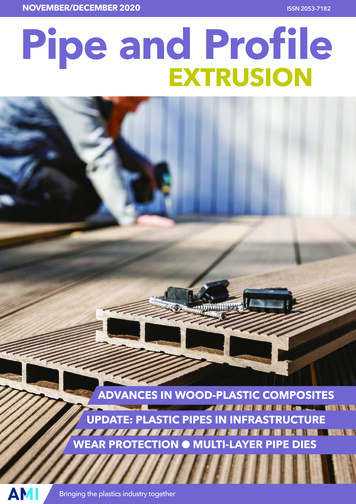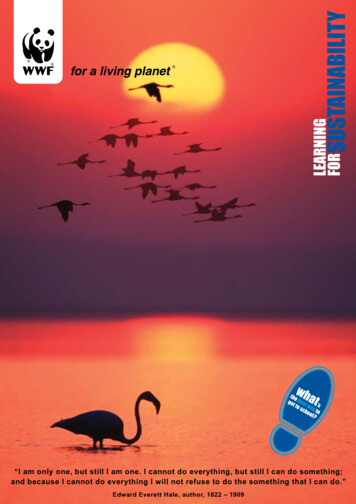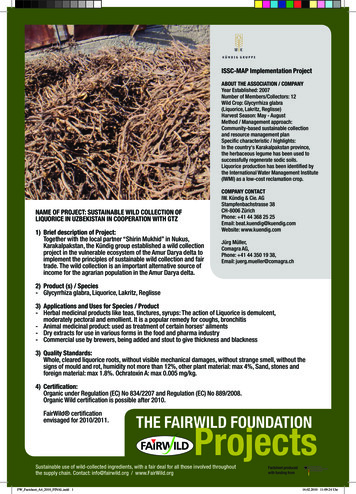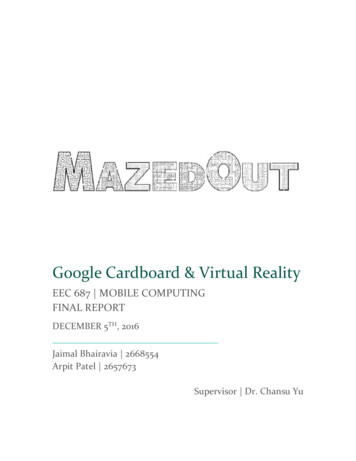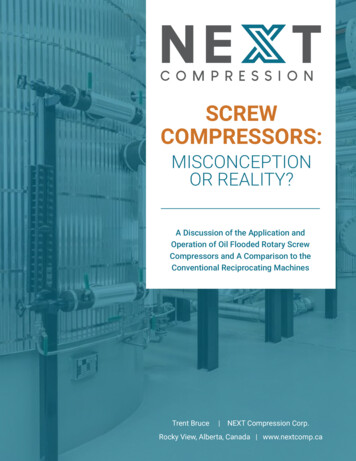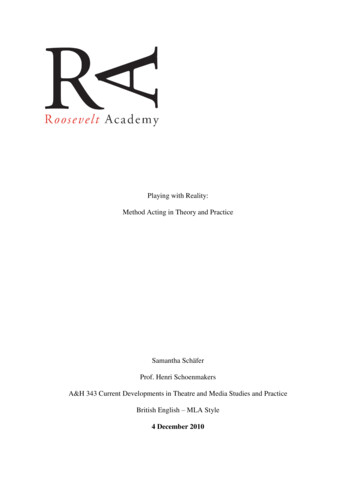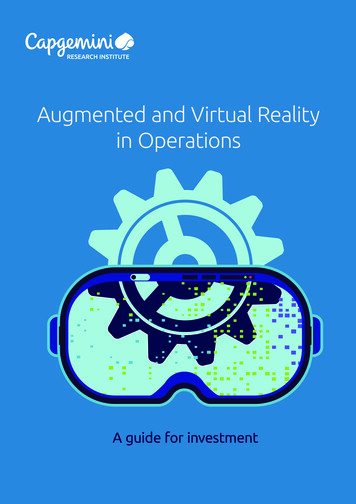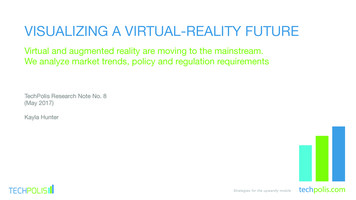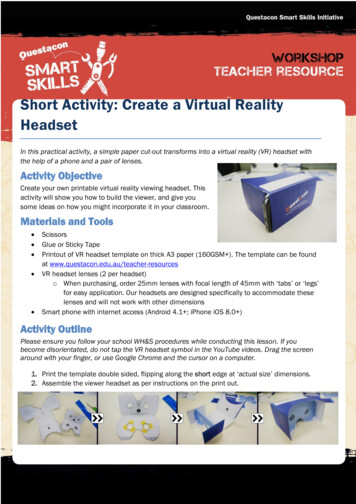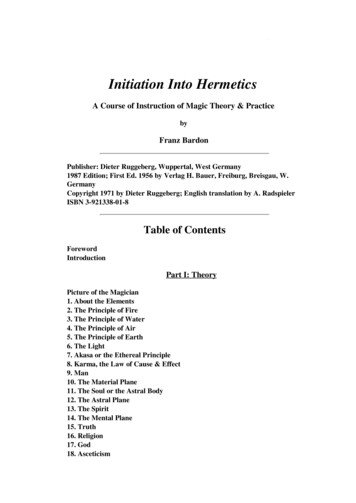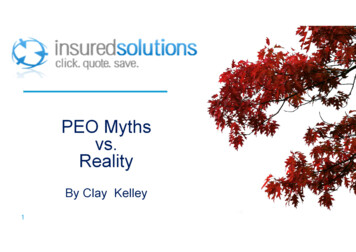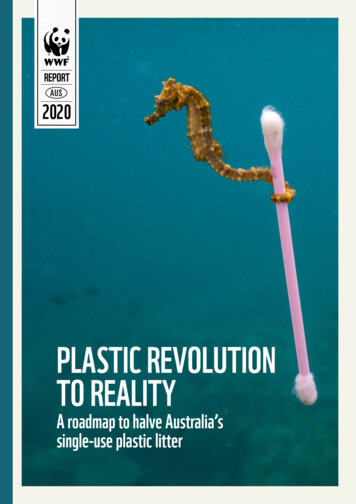
Transcription
2020PLASTIC REVOLUTIONTO REALITYA roadmap to halve Australia’ssingle-use plastic litter
Credits and acknowledgementsThe report was written in association with Boston ConsultingGroup, and the team comprised Sarah Black, Kayne Harwood,Susanna Lees, Keet Kuhanandan, James Clements, KatherineDickson, Paulien Mijer, Lucie Le Miere, Joyce Guo, Des Kheng,Vinisha Rathod and Kirsten Lees.CONTENTSINTRODUCTION5EXECUTIVE SUMMARY61. CASE FOR CHANGE10Why we need to take action11Plastic pollution baseline142. ROLE OF GOVERNMENT16Role of governments and plastics policy response levers18Australian regulatory status213. ACTION PLAN24Recommended future state and roadmap26Summary of recommendations284. DETAILED RECOMMENDATIONS32Plastic bottles34Published in July 2020 by WWF.Soft ‘scrunchable’ plastics38Any reproduction in full or in part must mention the title andcredit the above-mentioned publisher as the copyright owner.Disposable foodware44 Text 2020 WWFDisposable packaging and containers48Front cover photo: Justin Hofman / CES62Boston Consulting Group (BCG) partners with leaders inbusiness and society to tackle their most important challengesand capture their greatest opportunities. BCG was the pioneerin business strategy when it was founded in 1963. Today, wehelp clients with total transformation—inspiring complexchange, enabling organisations to grow, embedding sustainablebusiness practices, building competitive advantage, anddriving bottom-line impact. Our diverse, global teamsbring deep industry and functional expertise and a range ofperspectives to spark change. BCG delivers solutions throughleading-edge management consulting along with technologyand design, corporate and digital ventures—and businesspurpose. We work in a uniquely collaborative model acrossthe firm and throughout all levels of the client organisation,generating results that allow our clients to thrive.WWF is one of the world’s largest and most experiencedindependent conservation organisations, with over five millionsupporters and a global network active in more than 100countries. WWF’s mission is to stop the degradation of theplanet’s natural environment and to build a future in whichhumans live in harmony with nature, by conserving the world’sbiological diversity, ensuring that the use of renewable naturalresources is sustainable, and promoting the reduction ofpollution and wasteful consumption.WWF-Australia acknowledges the Traditional Custodians ofCountry throughout Australia and their continuing connectionto land, water and culture. We pay our respects to their Elders past, present and emerging.WWF-AustraliaLevel 1/1 Smail St,Ultimo, NSW 2007, AustraliaBoston Consulting GroupLevel 26, 60 Martin Place,Sydney, NSW 2000, Australiawww.wwf.org.auwww.bcg.com
BRENT STIRTON / GETTY IMAGES / WWF-UKINTRODUCTIONOBJECTIVEWWF has a global mission to achieve no plastic in nature. In pursuit of this,WWF-Australia is seeking to prevent single-use plastics from entering ouroceans and endangering our marine wildlife. This report has been developedin association with Boston Consulting Group, to address this issue.The report recognises that the federal, state and territory governments have,or are in the process of, setting admirable goals to reduce plastic waste. Wealso recognise the complexity and urgency of the problem; comprehensive andcoordinated regulations addressing all elements of the plastics value chainare required to create a sustainable solution. This report aims to contribute tothis process by providing recommendations on the most problematic plasticsleaking into the environment to enable government to confidently takeregulatory action.SCOPEThe report focuses exclusively on the six most problematic categories ofconsumer single-use plastics. These are:1. plastic bottles,2. soft ‘scrunchable’ plastics,3. disposable foodware,4. disposable packaging & containers,5. cigarettes, and6. microplastics.For these six categories of single-use plastic, this report recommends arange of policy levers across product design, use and disposal to reduceconsumption, increase rates of reuse and recycling and ultimately reduceleakage into the environment. This report does not consider the additionalregulation, processes or infrastructure required after an item has beenrecovered, to treat, sort and/or repurpose plastics and to encourage demandfor recyclates. Neither does it consider the broader, secondary benefitsof addressing the plastics issue, such as job creation and reduction ingreenhouse gas emission.METHODOLOGYThe report examined global success stories and leading research for eachof these priority plastics. The proposed solutions and regulatory actionspresented have been developed for the Australian context. Note that allvalues calculated for the purpose of this report are assumption-basedapproximations.Revolution to Reality; a roadmap to halve Australia’s plastic litter5
SHUTTERSTOCK / JOHN CUYOS / WWFTACKLINGSINGLE-USE PLASTICSIN OUR OCEANSEXECUTIVE SUMMARYTo date, approximately 9.7billion tonnes of plastics havebeen produced worldwide;more than one tonne of plasticfor every person alive. Seventyfive per cent of which hasbecome waste, which is largelymismanaged.Annual global plastic production reached 454 million tonnes in 2018and it is estimated that 25 million tonnes of plastics leaks into theenvironment each year, of which more than eight million tonnesend up in the ocean. This causes significant damage to marine speciesand ecosystems, as well imposing serious economic costs. In the Asia-Pacificregion, marine debris costs economies at least US 10.8bn per annum withthe projected total cost reaching US 216bn by 2050.In Australia, we consume 3.5 million tonnes of plastic annually, ofwhich 130,000 tonnes leaks into the marine environment. This represents fivekilograms of plastic entering the ocean per person each year, more than threetimes the global average. We estimate that one million tonnes of Australia’sannual plastic consumption is single-use plastics, which are beneficial for onlya few hours to a few days, but if not recovered and recycled, last hundredsto thousands of years in the environment. For these single-use plasticsconsumed in Australia each year, we estimate that fewer than 180,000 tonnes(18%) are recovered through recycling, 710,000 tonnes (71%) go to landfilland 110,000 tonnes (11%) leak directly into the environment, much of whichends up in the ocean.The plastics problem will not resolve without a revolution in theway we produce, consume and dispose of plastic. Government,industry and consumers all demonstrate an appetite for change and thesolutions exist, however the problem persists and is compounding. By 2050,estimates indicate that plastic will outweigh the fish in the ocean.By 2050, estimates indicate that plasticwill outweigh fish in the ocean.6WWF-Australia Report 2020
This report brings our collective ambition for actioncloser to reality by presenting the first comprehensiveset of recommendations for the six most problematiccategories of consumer single-use plastic.Industries and individuals cannot solve the plastics problem alone nor atthe pace required. Only government has the levers to catalyse a transitionthat sufficiently addresses the problem at scale and in a timely, cost-effectivemanner: Regulation of plastics is increasing rapidly around the globe,however has so far been narrowly targeted and fragmented, e.g. onlydealing with easier categories to phase out like plastic bags. Australian federal, state and territory governments are settingambitious targets, and there is significant work still required to detailhow targets will be reached and to coordinate and unify regulations. COVID-19 has reinforced the critical role governments play incoordinating responses to crises and catalysing rapid change. International coordination is needed to save Australia’s marineenvironments. Plastic waste travels the globe and some of the countrieswith the largest contribution to marine plastic pollution are in our region.PLASTICBOTTLESDISPOSABLEPACKAGING DISPOSABLEFOODWAREMICROPLASTICSWe estimate these six categories account for 70% of the annual single-useplastics consumption in Australia and contribute to 75,000 tonnes of the130,000 tonnes leaked into the environment each year.If adopted, this report’s recommendations have thepotential to:Three actions are proposed for the Australian federal,state and territory governments to reduce consumption anddisposal of the six most problematic plastic categories andultimately prevent plastic leakage into the ocean:1. Develop a road map with clear milestones tophase out most types of disposable foodware, packagingand containers, as well as cigarette filters and microbeadsin the near future, reducing annual consumption ofsingle-use plastics by 85,000 tonnes and leakage by9,000 tonnes.2. Enact regulation to manage single-use plasticsthat can’t be phased-out through product standards (e.g.designing for recyclability), policies to capture the fulllifecycle costs (e.g. extended producer responsibility) andmeasures to improve collection (e.g. container depositschemes), decreasing annual consumption by 100,000tonnes, increasing recovery by 160,000 tonnes per yearand reducing leakage by 35,000 tonnes per year.3. Incentivise development and broadscale adoptionof sustainable alternatives and systems to assistthe transition away from single-use plastics.1. Reduce our consumption of the most problematicsingle-use plastics by a quarter;2. More than double the rate of recovery of these plasticsfor recycling;3. More than halve leakage of these plastics into theenvironment.8WWF-Australia Report 2020It is critically important to get the design and implementation of regulationsright in order to avoid negative impacts on vulnerable populations andexcessive burden on industry, as well as to maximise the positive economicpotential for local industry. All actions also need to be complementedby public education/awareness campaigns and industry and communityengagement to be effective.Revolution to Reality; a roadmap to halve Australia’s plastic litter9
HANNELE LAHTI / NATIONAL GEOGRAPHIC CREATIVE1. THE CASEFOR CHANGE CURRENT STATEOF PLASTICS ANDCASE FOR CHANGEWE ESTIMATE THATONE MILLIONTONNESOF AUSTRALIA’SANNUAL PLASTICCONSUMPTION ISSINGLE-USE PLASTICSTHE AMOUNT OFSINGLE-USE PLASTICENTERING THE AUSTRALIANENVIRONMENT EACH YEARIS HEAVIER THANTWO TITANICSGlobal plastic production hasincreased exponentially, fromtwo million tonnes in 1950 tomore than 454 million tonnesin 2018.1To date, approximately 9.7 billion tonnes ofplastics have been produced, more than onetonne of plastic for every person alive.2 If we don’t make a concerted effortto change consumption patterns, production is expected to triple by 2050.3To date, seventy five per cent of all plastic ever produced has become waste, 4which is largely mismanaged.5 An estimated 25m tonnes of plasticsleaks into the environment each year,6 of which more than eightmillion tonnes end up in the ocean.7 If this continues, by 2050 plasticwill outweigh fish in the ocean.8Plastic pollution is having devastating effects on wildlife and ecosystems.Animals get entangled in large plastic debris, leading to acute and chronicinjury or death. Wildlife entanglement or ingestions affects approximately 415different species, including mammals, reptiles, birds and fish.9 Animals alsoingest large quantities of plastic and are unable to pass the plastic throughtheir digestive systems, resulting in internal abrasions, digestive blockages,and death. Every year humans and animals continue to ingest plastics fromfood and drinking water, with the full effects still unknown. There arealso serious economic costs. In the Asia-Pacific region marine debris costseconomies at least US 10.8bn per annum and the total cost could reach US 216bn by 2050.10In Australia, we consume 3.5m tonnes of plastic annually,11 ofwhich 130,000 tonnes leaks into the marine environment.12This represents five kilograms of plastic entering the ocean perperson each year, more than three times the global average.13 Weestimate that one million tonnes of Australia’s annual plastic consumptionis single-use plastics, which are beneficial for only a few hours to a few days,but if not recovered and recycled last hundreds to thousands of years in theenvironment. For these single-use plastics consumed in Australia each year,we estimate that fewer than 180,000 tonnes (18%) are recovered throughrecycling, 710,000 tonnes (71%) go to landfill and 110,000 tonnes (11%) leakdirectly into the environment, much of which ends up in the ocean.14Revolution to Reality; a roadmap to halve Australia’s plastic litter11
8bnCIGARETTES600mPLASTIC BOTTLESDISPOSABLE FOODWARE7bn166mSOFT PLASTICS275mDISPOSABLE PACKAGING JÜRGEN FREUND / WWFWEIGHT OF PLASTIC LEAKEDINTO THE AUSTRALIANENVIRONMENT IS EQUIVALENT TO
This report focuses on the six most problematic categories of single-useplastics according to prevalence in debris clean-upsWe estimate these six categories account for 700K tonnes of consumption andcontribute 75K of the 130K tonnes leaked into the marine environment annuallySix categories of consumer single-use plastics make up the majority of litter collectedfrom the environment and pose the greatest threat to the marine environment: 1) plasticbottles, 2) soft ‘scrunchable’ plastics, 3) disposable foodware, 4) disposable packaging & containers, 5)cigarettes and 6) microplastics. We estimate these categories account for 700,000 tonnes (70%) of thesingle-use plastics consumed each year and contribute 75,000 tonnes of the 130,000 tonnes leaked intothe marine environment annually.15Baseline view of the volume of single-use plastic entering the Australianenvironment (2017-18, K tonnes)17LeakedRecovered12%10%35%Number of plastic items collected in clea
tonne of plastic for every person alive.2If we don’t make a concerted effort. to change consumption patterns, production is expected to triple by 2050.3. To date, seventy five per cent of all plastic ever produced has become waste,4. which is largely mismanaged.5An estimated 25m tonnes of plastics.
